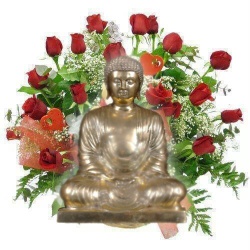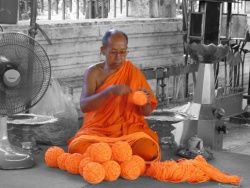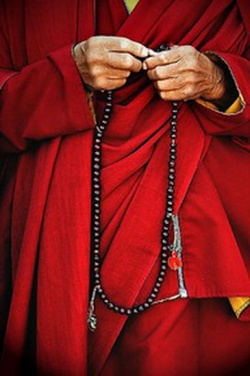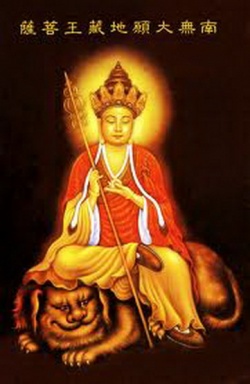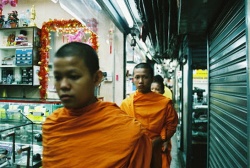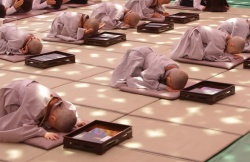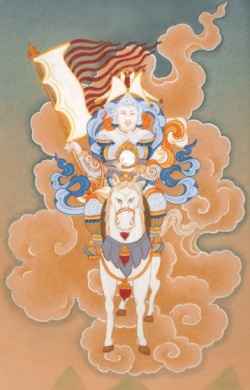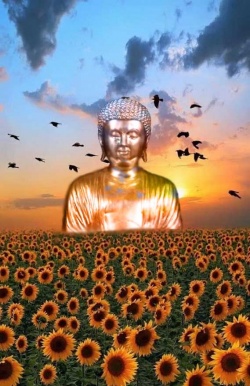Awareness of the Void
At some point, either before or after the initial enlightenment experience—at least in my tradition—you must become absolutely certain that you are not your body.
All that you know is consciousness. Think about it. Everything you experience, your body, the world, thinking, memories, science, history, dreams, other people--all happen in your consciousness. If something happens outside of your consciousness, such as a storm while you slept, or Lincoln’s assassination, you only know about it if someone, or something within your consciousness tells you. That learning occurs now, within your present consciousness. Of course, you can also infer something happened by after effects, such as wet ground implies there was rain. Yet, even that inference is a thinking, a speculation, and it occurs in your present consciousness. All memory about the past and thinking about the future, occurs in your now consciousness. Thus, all knowing and experience occurs now. It is then obvious that you need to experience and understand now-consciousness.
If all that you know or experience is consciousness, then you too, at least for argument’s sake, are consciousness. Your consciousness is not limited by body, mind, world, time or space; all these occur within your consciousness as objects of that consciousness.
Even the intangible, the invisible, and the hidden, such as an atom, or gravity, are known only by inference from present experience in your now consciousness. The inference to the unobserved, such as the existence of an atom, or a gravity wave, is a mental process occurring within your present consciousness too. Atomic physics, cosmology, and all of science becomes a set of inferences about hidden and non-hidden objects and forces, derived from simple acts of perception conjoined with a set of mental functions we call inference or logic, which are also happenings in now consciousness.
So what is this now-consciousness? Intellectually understood it is called mind. Others would call it imagination. It is all mental stuff. This, of course doesn’t help understanding one whit except that it is a pointer that helps you get before the concept that the body it real, and by real, I mean as having its own, autonomous self-existence. Its existence is imaginary, mindstuff.
I must admit my own evolution appears idiosyncratic. That is, for many years before awakening, I was conscious of an almost palatable emptiness or Void. When I described it to someone else, he ascribed it to seeing God.
The only persistent mention I see of it is in Mahayana, where the Void’s meaning is explained according to differing schools, and Vajrayana Buddhism, such as the Tibetan Kargya school. It is only in the latter that I see much description of the experience of the Void (as opposed to the theory of the Void), or the mention that the essential quality of mind, mental space, is that of clear light.
The clear light experience is found when the mind is quiet, and the light of consciousness, which is always there, rather than a background awareness, becomes the foreground awareness. That is, the light becomes a more compelling experience than any object within mind. The screen, so to speak, becomes more important than the play of images that make a movie.
How to get to this place is explained further on another page on this site, but it is so important that it is worth repetition.
When at first we look within, rather than at an object in the world, we only find darkness. However, as our ‘inner eye’ ‘adjusts’ to the darkness of the mental space within, the darkness gradually gives way to an inner light. It is like entering a darkened movie theater. The eyes have to acclimatize before they see the reflected light from the movie. That inner light illuminates a mental world of emptiness, or void. Many years of looking leads the inner emptiness to expand, and the light to illuminate it ever more brightly.
Mahayana and Vajrayana Buddhists call this clear, self-illumined Void our true nature. Our true nature is nothingness, this nothingness-emptiness, which is absolutely clear, is illumined by its own light.
At first, this light appears different from physical light. It is less clear, less intense and less ‘grabbing’ of attention. However, over the years, its intensity grows and its manifested forms change. Color patterns and shadows dance and fill its radiance. An inner movie of insubstantial forms plays to its one audience. Eventually the meditator discovers that the inner light and outer physical light are the same. They arise out of the basic functioning of vision consciousness itself. Of course there is sound consciousness and that is described in many other sources.
Knowing this inner Void of light and peace leads to dramatic changes in one’s belief systems. For example, no matter how hard you look, no matter how long you look within, and that within becomes a clear, light, Void, you cannot find an I.
With your eyes open, operating and functioning in the world, you may act like a me, and even feel like a me if you turn your attention to yourself. However, if you stop and look within, eyes open or closed, trying to pursue the I, whether it is a thought or a feeling, you cannot find it. Even if you turn even further inward to look for the one who is looking, you will find the same self-illumined emptiness only. That’s it. That’s all you’ll ever find looking within.
Looking within and abiding within, means getting to the non-experiential state lying beneath (or before) thoughts, feelings or sensations.
All that you find is nothingness, a lighted void. While this experience may not change you radically, you do begin to wonder who is it that exists, and what is the nature of that existence.
One day the realization comes that within the entire fabric of your being there is no I at all. There never has been an I. There is no coordinator. There is no thinker.
You discover there are thoughts, but no thinker. There are actions, but no actor. There are decisions, but no decision maker. There is movement, but no mover. There is life, but no one who lives. There are trees, but no perceiver.
Everything takes place without a perceiver or organizer. Thoughts come and go, but they are like drops of rain, not something you create and implement. Everything happens without a central point of I-ness.
When this absence of I is clearly understood, your world is turned upside down. Without an I, there is no other opposed to it. I and other become one. I am no longer different from my percept, because there is no longer a me. There is percept, and I am that. There is only one field of perception, undivided by categories of me and thee, I and Thou, inner and outer, and I am all that.
With the disappearance of the I-idea, there is the temporary replacement by the Oneness-idea. You go around saying there is only One, only One! However, even this Oneness-idea is eventually overturned because we realize it too, is only an idea. With the disappearance of the I-idea, all ideas begin to vanish too. Atom is an idea. Quantum is an idea. Communism and capitalism are ideas, as is central bank, gross domestic product, integrity, dishonesty, brain, pancreas, and even Oneness and consciousness. They all disappear and with them, the existence of that which they purportedly denoted. The world is not other than mind and mind is no other than thoughts.
Soon our apparent brains begin to close out random thoughts and we begin to really look at our direct experience without the intervention of thought or the guidance of theory and memories of how things ought to be. The world revealed is vastly different from the world we thought we lived in.
We eventually discover we are not human beings at all, trapped in a body doomed to death, but we are everything we experience. We are the totality of consciousness. Without the I to limit us, without an I to direct our lives in routines of please and pain avoidance, we are allowed to expand and take ownership of the totality of real existence. We leave behind the world of thought existence.
The inner world and the outer world come together. The inner world of vast, inner, self-illumined space merges with the outer world of objects and sense impressions. When you look within you see the inner light, and when you look without, everything you see is illumined by physical light. When you walk into a dark room, you leave the physical light behind, and you see only the inner light. One day you realize that inner light is always there, even in the external world of sunlight. One day you realize there is only light. Sometimes you may call it sunlight, or lamplight, and sometimes you may call it inner light. However, there always is light, and that light illumines all, whether an inner fantasy or an outer tree.
When we are quiet and still, sometimes the inner vastness opens completely, and we, as discrete sentient objects, as subjects, disappear completely, to be replaced by our totality of experience of the world. The boundary between the trees and us disappears, and we become the trees. We become the sound of the tree blowing in a breeze. We become the jet plane overhead. Body and mind disappear completely, and we become the totality of experience, including portions of body experience mixed in.
We experience we are not the body. We are the totality of experience. We are the totality of consciousness, which includes the experience of the body as a part of a larger totality.
Now comes a most important step. We begin to investigate the body as an object of consciousness, and therefore, like all objects in consciousness, it too is consciousness. We explore the body as consciousness, just as we explored the vast, inner emptiness.
Since the vast, inner, self-illumined emptiness is now always present, eyes open or closed, it is not surprising to see that the body too has this quality. The body is experienced in many ways. We can touch it, and be touched by it. We can hear the sounds it makes. We can taste its skin, and we taste our mouths. We can see portions of it with our eyes open. We can feel its muscles moving. We can feel our lungs pulling in air. We can feel a headache or muscle strain. We can look within, using our inner vision and find the lighted void that permeates all sensations of touch, taste, smell, sight, and inner feelings.
We begin to see the body is essentially empty and light, as is everything else within consciousness, as well as it should be, because the body too is only another object within consciousness, and thus is consciousness itself.
Whether there is something that reincarnates into a new body is a moot point. Speculating about it does not help you know yourself first hand. Someone who has recognized there is no I can see there is nothing to reincarnate, except the vast, self-illumined Void. But, this is everyone’s void, everyone’s true and original nature. Who can say that this part of the Void is me, and that will reincarnate?
The same self-illumined speck of void is in everyone and permeates everyone’s every experience. The void is everyone and contains everyone. The void is One. As the Prajna Paramita Hridaya Sutra so succinctly states: Form is no other than Emptiness, Emptiness no other than form. Feeling, thought, sensation, and consciousness are also like this. All forms arise out of the Void, and return to the Void, just as clouds materialize from a clear sky, and after an hour or a week, dissipate back into the clear sky.
Perceiving the body and its experience from the inside, with the understanding that it too is consciousness, changes the body’s experience. Things no longer happen to it as a passive subject. Rather, the body and environment are inseparable. One cannot experience one without the other. In fact, the body is the One world, and the One world is the body.
Sensations become less substantial. They are all permeated by emptiness. They feel less cluttered, more discrete and clear, but at the same time, less substantial, and in a sense, less "real." We often use the term ‘real’ synonymously with hard, tangible, or especially impactful sensations. However, all sensations now occur within a simultaneously perceived vast emptiness, which is as real as the sensations.
The experience is a little like seeing the old pirate hologram at Disneyland’s Pirate Cove. There is a discrete image of light with the form of a man, but you can see through the image, as if it were a ghost. It has an intangible, empty feel about it. So too become the body’s sensations. They seem less substantial, and less real, which is good if you are dying a painful death, but bad if you are having enjoyable sex.
Another result of the constant presence of the Void is that no experience is more important than any other portion of the totality of the experience. The body is no more important than the tree. With increasing freedom from the demands of the world, we can begin to explore our experience of our bodies more closely. One day we make the remarkable discovery: we have no bodies!
We realize that the body, like our sense of I, is only a concept. There is no central experiencer of the body that coordinates the body’s many sensations and perceptions. If you look closely at the body, examine each sensation moment by moment, you will understand completely, there is no such thing as the inner experience of the body as a totality. The sense of body totality is a concept only. Try it, you’ll see this is true. You must become convinced that you have no body by this direct experience before you can become free. In fact, this appears to be the essence of Ramana Maharshi’s experience. He discovered he was not his body. He did not find realization through self enquiry as he taught everyone else to do, but through a process where he realized he was not his body. I call this sort of self-investigation Microanalysis, and it is a great adjunct to the "Who Am I?" sort of self-enquiry.
If we look at our experience of our bodies from the inside, in a careful, thorough manner, we discover all sorts of things. At any one time we only experience portions of our bodies’ feelings. Sometimes we feel a muscle tightness in the neck or back. Sometimes just the pressure of the chair against the buttocks. Sometimes we experience the taste in or mouths. Sometimes a tingling sensation on the feet. Sometimes we feel our heart beating, and sometimes we hear it.
Though many sensations may vie for our attention, and reside on the edges of direct awareness, we actually can only attend to one sensation of the whole at a time. It is like trying to hold onto two thoughts at a time-impossible. Just as you cannot think two thoughts at the same time, you cannot attend to two sensations simultaneously.
While we can examine one sensation after another, either randomly, or in a linear fashion, we cannot experience them all at once. Nor can we experience the body as a whole, as one complete form. If you think you do, please examine that wholeness feeling. You will discover that the experience of the body as a whole, is in fact, an "enduring" image, a fantasy, not an actual experience of the body as a whole. We have a body image, imagination, so to speak, derived from many years of body experience, and this image acts as an inner cognitive reference map that gives all the random sensations a meaning within the context of that map, i.e., a banged toe, hot mashed potatoes in the mouth.
It also becomes clear that the external world has its own reference map, but that map is still within our imagination. It then comes as no surprise that they are the same: reference maps of various dreams.
For example, I will have a sudden slight burning ‘pain’ somewhere. I search through my memories of similar sensations, until there is a match. I can then declare it a foot pain or a back pain based on past experience. Back sensations are different from foot sensations. The body image then gives me a map, and I place that pain in my body image’s foot. I can then reach down and rub my foot.
Isolating the spatial location of any body sensation from the inside is impossible without this body image map. The map is not itself a sensation or perception of the body. It is an image, born of experience, and supported by our ideas about our body. In fact, for most people, the body image grabs more attention than the sensations, which means we do not experience our experience, but we experience our ideas about ourselves.
This all leads up to my initial statement and final conclusion, the requisite knowledge of awakening: You have no body. The body is only a concept. There are only scattered sensations and perceptions that the brain puts together with a body image. There is only One experience, one field of consciousness, and you are that, the totality of all that is.
Robert used to say, "You are nobody, No Body at all." The body idea is very limiting. You are much more than the body and its many sensations. These all come and go, but who you are essentially, stays the same: Emptiness, without form, vast like space, lighted by its own light. But even this emptiness is not you. It is added to you. Form dissolves into emptiness and both into you.
You are not your body. In effect, you have no body, nor is there a you to have one. No body, no you. Even consciousness is just a concept. The vast, self-lighted Void too, is just a concept, a knowing added onto your emptiness nature. These concepts are both stepping stones and hindrances to discovering who you are, without words, images or concepts. About This, nothing can be said, because that which can be said has nothing to do with you.
